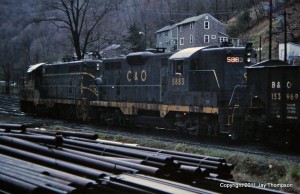- Size: 18′ x 12′
- Scale: HO
- Minimum Mainline Radius: 30″
- Minimum Aisle Width: 36″
- Designed by Dan Bourque
 The C&O’s Cabin Creek Sub was one of several large coal branches extending south from the C&O mainline along the Kanawha River in the heart of West Virginia. At the end of the Cabin Creek Sub was Kayford, WV, home to a maze of track work serving a handful of tipples including the large Truax-Trauer (later Oglebay Norton) Shamrock Preparation Plant. The C&O hauled loads of raw coal up the steep 2.4% grade (up to 3.4% in places) and then hauled clean coal back down.
The C&O’s Cabin Creek Sub was one of several large coal branches extending south from the C&O mainline along the Kanawha River in the heart of West Virginia. At the end of the Cabin Creek Sub was Kayford, WV, home to a maze of track work serving a handful of tipples including the large Truax-Trauer (later Oglebay Norton) Shamrock Preparation Plant. The C&O hauled loads of raw coal up the steep 2.4% grade (up to 3.4% in places) and then hauled clean coal back down.
The Layout
This layout is designed to fit a lot of branch line operation into a large bedroom, 16′ x 12′ with a closet. It captures the layout at Kayford, WV in the 1960s including the huge Shamrock Prep Plant, Acme No 2 tipple, the smaller Raccoon and Kayford tipples, and the raw coal dump high up on the hillside behind the Kayford loader. The Shamrock Prep Plant is the centerpiece of the layout, and this plan allows the tipple to be modeled to scale, loading over seven tracks. The rest of the layout represents the cast of supporting tracks to serve the prep plant, the most important of which was the spur along the hillside where raw coal was dumped. A small yard in front of the Kayford tipple helps mine runs work around all the cuts of cars needed. The small Raccoon loader is modeled at the end of the branch near the door along with a portion of the long row of company houses that formed the town of Kayford. At the other end of the modeled portion is Acme No 2–while the loader tracks were double-ended, this plan has them stubbed to avoid an inaccessible yard ladder on the backside of the tipple. Most of the tracks in the plan are on a steep grade (prototypical), so some sort of brake mechanism would be needed to hold cars in place when not coupled to a locomotive.
Staging (Cane Fork Yard) is reached via a 2.5 turn helix, and staging is in a reversing loop of 4-5 tracks to make turning mine runs easier. An access hatch is designed into the middle of the staging loop for access to tracks along the wall–the opening could be hidden by a high hillside behind the Shamrock tipple. Because only one mine run at a time would work Kayford, DCC wouldn’t be necessary, but it would make wiring and operation more simple. Walk-around throttles would be helpful for switching duties.
Operations
This track plan is really designed for 1-2 operators, but a full “day” might consist of multiple mine runs and take 2-3 hours. Each day would consist of a series of “shifters” (C&O for “mine runs”) between Cane Fork and Kayford. Each shifter, led by 2-3 GP7s or 9s in the ’60s, a pair of AS-616s in the late ’50s, or a 2-6-6-2 in the ’40s or early ’50s, would bring a mix of loads (raw coal) and empties. Empties would be needed for all four tipples, and raw coal would be run past Kayford and backed down to the long tail track above the raw coal dump. Additional empty hoppers would be pulled from one of the tracks between the dump and main–these would be placed at the Shamrock plant after clearing the loads from the stub tracks. Photos from the 1950 suggest loaded cars were dropped in ragtag cuts all the way between the tipple and the connection with the main, so some clean-up work to organize and couple cuts would be needed. The placing of empties and pulling of loads would take several movements to complete, using the small yard and the main between Kayford and Raccoon to make up the final loaded train.
To make each shifter a little different, it could be tasked to serve the Shamrock plant (by far the busiest loader) and one additional loader (Raccoon, Acme No 2, or Kayford). The raw coal for the Shamrock Prep Plant came from other Truax-Trauer / Oglebay Norton operations, and these included Raccoon, Acme No 2 and Kayford. While I don’t know for sure, I suspect cars of raw coal from these tipples may also have been dropped off for Shamrock, though Acme was probably capable of cleaning its own coal, and the arrangement of the conveyors at Kayford suggests the coal could easily be taken directly to Shamrock without loading it in railcars. Still, hauling loads from Acme and Raccoon to the raw coal dump would add extra on-layout switching with both the origin and destination for a car move on the layout.
Things I Like About this Plan:
- Interesting operations in a small area
- Inclusion of a very large loader modeled to scale
- Plenty of staging
- Ability to run long trains (~35-40 cars)
- Wide aisles and decent radius for a bedroom plan
Things I Don’t Like About this Plan:
- Need for lots of brakes to hold cars
- Unable to model the town of Kayford along the tracks
- Operations could be repetitive
Related Products:





